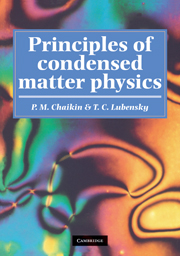Book contents
- Frontmatter
- Contents
- Preface
- 1 Overview
- 2 Structure and scattering
- 3 Thermodynamics and statistical mechanics
- 4 Mean-field theory
- 5 Field theories, critical phenomena, and the renormalization group
- 6 Generalized elasticity
- 7 Dynamics: correlation and response
- 8 Hydrodynamics
- 9 Topological defects
- 10 Walls, kinks and solitons
- Glossary
- Index
9 - Topological defects
Published online by Cambridge University Press: 05 June 2012
- Frontmatter
- Contents
- Preface
- 1 Overview
- 2 Structure and scattering
- 3 Thermodynamics and statistical mechanics
- 4 Mean-field theory
- 5 Field theories, critical phenomena, and the renormalization group
- 6 Generalized elasticity
- 7 Dynamics: correlation and response
- 8 Hydrodynamics
- 9 Topological defects
- 10 Walls, kinks and solitons
- Glossary
- Index
Summary
In Chapter 6, we studied the states of systems with broken continuous symmetry in which the slowly varying elastic variables described distortions from a spatially constant ground state configuration. These distortions arose from the imposition of boundary conditions, from external fields, or from thermal fluctuations. In this chapter, we will consider a class of defects, called topological defects, in systems with broken continuous symmetry. A topological defect is in general characterized by some core region (e.g., a point or a line) where order is destroyed and a far field region where an elastic variable changes slowly in space. Like an electric point charge, it has the property that its presence can be determined by measurements of an appropriate field on any surface enclosing its core. Topological defects have different names depending on the symmetry that is broken and the particular system in question. In superfluid helium and xy-models, they are called vortices; in periodic crystals, dislocations; and in nematic liquid crystals, disclinations.
Topological defects play an important role in determining properties of real materials. For example, they are responsible to a large degree for the mechanical properties of metals like steel. They are particularly important in two dimensions, where they play a pivotal role in the transition from low-temperature phases characterized by a non-vanishing rigidity to a high-temperature disordered phase.
This chapter begins (Sec. 9.1) with a discussion of how topological defects are characterized and a brief introduction to the concepts of homotopy theory.
- Type
- Chapter
- Information
- Principles of Condensed Matter Physics , pp. 495 - 589Publisher: Cambridge University PressPrint publication year: 1995
- 5
- Cited by

